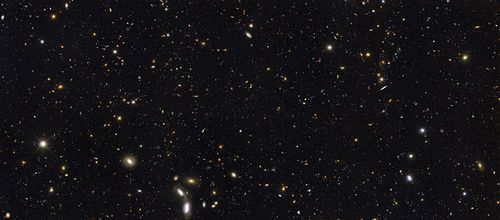
This image of a "dark field" was taken by the Great Observatories Origins Deep Survey project using NASA's Hubble Space Telescope. The full program has just released a multi-wavelength catalog of 34,930 galaxies, enabling astronomers to study the evolution of galaxies in the early universe.
From the entire span of cosmic time, two epochs are particularly of great interest: "cosmic high noon," from which period light has been traveling for about ten billion years, and "cosmic dawn" with much older galaxies whose light has been en route to us for about thirteen billion years. During the former period, cosmic star formation activity reached its peak; the latter period is when neutral atoms in the cosmos became ionized.
CfA astronomers Giovanni Fazio, Steve Willner, and Matt Ashby are the PI and key team leaders, respectively, of the Spitzer Infrared Array Camera (IRAC). Along with a large team of colleagues, they have just published a multi-wavelength catalog -- from the ultraviolet to the infrared -- of 34,930 galaxies spanning the cosmic high noon and cosmic dawn taken with IRAC, HST, and other telescopes in the direction of five popular "dark fields."
The large sample of remote systems is called CANDELS (The Cosmic Assembly Near-infrared Deep Extragalactic Legacy Survey). It is able to detect star forming galaxies smaller than our Milky Way at these huge distances with a 50% completeness level, and more passive, fainter galaxies with somewhat less sensitivity. The new catalog makes it possible to study for the first time with statistical precision how galaxies evolved in the universe into predominantly two kinds: bluish, active spiral galaxies, and red, passive elliptical galaxies.
For a little more insight into the project see this:http://www.cfa.harvard.edu/news/2013/su201328.html(SY)
